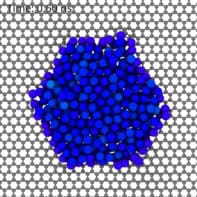
A new technique for cooling a macroscopic object with laser light has been demonstrated by a team of physicists in Germany and Russia. Making clever use of the noise in an optical cavity, which normally heats an object up, the technique could lead to the development of “stable optical springs” that would boost the sensitivity of gravitational-wave detectors. It could also be used to create large quantum-mechanical oscillators for studying the quantum properties of macroscopic objects or to create components for quantum computers.
Physicists already have ways of cooling tiny mirrors by placing them in an optical cavity containing laser light. When the mirror is warm, it vibrates – creating a series of “sidebands” that resonate with light at certain frequencies. The first lower sideband has a frequency equal to the difference between the resonant frequency of the cavity and the vibrational frequency of the mirror. So when a photon at that frequency enters the cavity, it can be absorbed and re-emitted with an extra quantum of vibrational energy. As a result of this “dispersive coupling” process, the mirror cools because energy from it is removed.
Dispersive coupling works best when the bandwidth of the cavity is much smaller than the vibrational frequency of the mirror. This is possible for relatively small mirrors with vibrational frequencies in the hundreds of megahertz. However, for more massive mirrors with vibrational frequencies in the hundreds of kilohertz, optical cavities with sufficiently narrow bandwidths are simply not available.
Cooling with noise
In this latest work, a large object was cooled using a new technique that involves “dissipative coupling” as well as dispersive coupling. Dissipative coupling was first proposed in 2009 by Florian Elste and Aashish Clerk of McGill University and Steven Girvin at Yale University. It makes clever use of quantum “shot noise” in laser light, which would normally be absorbed by the mirror and cause it to heat up.
However, if the mirror is in an optical cavity and its motion couples to the mirror’s reflectivity in just the right way, then there are two ways that the noise can reach the mirror: it can travel directly from the laser to the mirror or it can bounce around the cavity before driving the mirror. Just as in an interferometer, noise taking these two paths can interfere destructively or constructively.
Clerk and colleagues realized that the system can be set up so that destructive interference stops this quantum noise from heating the mirror but does not prevent the mirror from losing energy to the noise. The net effect is a strong cooling of the mirror’s motion, which could in principle take the mirror to its quantum ground state. “Unlike standard cavity cooling schemes, this interference doesn’t rely on having a very large mechanical frequency,” explains Clerk – meaning that it can be used to cool large mirrors that have low vibrational frequencies.
Couplings working together
In the latest work, Roman Schnabel and colleagues at the Max Planck Institute for Gravitational Physics in Hannover, Moscow State University and the Leibniz University of Hannover have now shown that dissipative and dispersive coupling can work together to cool relatively large mirrors. Based on an idea first proposed by the researchers in 2013, the technique uses a cavity created by a Michelson–Sagnac interferometer (see figure).
What they have done is to fire laser light at a beamsplitter to create two beams that go off at right angles to each other. These beams then bounce off two mirrors, making their paths form a right-angled triangle. Light from the output port of the interferometer is sent to a “signal-recycling mirror”, or SRM, where some of the light is reflected back into the interferometer and some is sent to a detector. The optical cavity is fine-tuned by adjusting the position of the SRM, while the cavity properties are monitored using a frequency analyser connected to the detector.
The object to be cooled is a silicon-nitride mirror just 40 nm thick, which is placed at the centre of the cavity. The mirror is about 1.2 mm across, weighs 80 ng and has a fundamental vibrational frequency of 136 kHz. The vibrational motion of the mirror changes not only the resonant frequency of the cavity – leading to the emergence of sidebands and dispersive cooling – but also the bandwidth of the cavity. When the rate of change of the bandwidth is large, energy can be exchanged between the cavity and the mirror. By carefully adjusting the phase between the vibrating mirror and the light, energy alone will flow from the mirror to the cavity, thereby cooling the mirror.
Sub-kelvin cooling
The researchers monitored the temperature of the mirror by using the laser light to measure its motion. They found that by using a combination of dispersive and dissipative cooling, they could cool the mirror from room temperature to 126 mK. Commenting on the experiment, Clerk told physicsworld.com that “Schnabel’s is the first experimental system where you have the special kind of dissipative optomechanical coupling that can let you do something truly new”.
One possible application of the technique is to use it to cool relatively large objects to their quantum ground states of vibration. Such quantum oscillators would comprise billions of atoms and could be used as “Schrödinger’s cats” to study quantum mechanics on a macroscopic scale. Other applications include using such quantum oscillators as components in quantum computers and other quantum-information systems.
Stabilizing an optical spring
However, it is not the cooling power of the technique that most interests Schnabel and colleagues. Schnabel told physicsworld.com that the demonstration is a proof-of-principle of their model of how light interacts with an oscillating mirror within a gravitational-wave detector. Their goal is to create a “stable optical spring” whereby a mirror in a huge interferometer undergoes a stable oscillation when laser light is shone on it. A gravitational wave travelling through the mirror would cause a tiny disruption in the oscillation, which would be detected by the interferometer. The problem is that noise in the system heats the mirror and causes it to vibrate erratically. This makes the measurement extremely difficult in existing set-ups.
“Our goal is to avoid uncontrolled heating of the mirror,” explains Schnabel, who says that the team will now use the model to try to create a stable optical spring using a 100 g pendulum as a mirror in a small interferometer. The ultimate goal of the research is use a mirror of about 40 kg for use in gravitational-wave detectors of the future.
The research is reported in Physical Review Letters.



